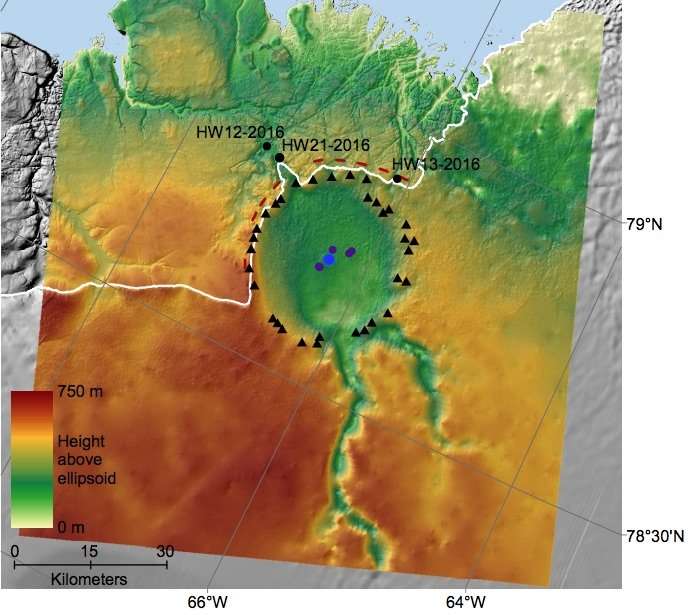As great as it would be to find a giant hunk of space rock or a baby Clark Kent to confirm a geologic indentation’s extra-terrestrial origins, scientists are usually not so lucky when examining a prehistoric crater. But there are a number of tell-tale signs that a big round hole in the ground was caused by a meteor impact.For instance, there are a number of minerals, like quartz, that undergo significant changes in their properties when exposed to the type of physical force and pressure brought by a meteorite. These changes make the minerals in a crater look different from those in the surrounding bedrock.Andrew Glikson, an earth scientist at Australian National University who studies asteroid impacts, was not involved with this study but “found it to document a bona-fide impact structure.”But others, like David Kring at the Lunar and Planetary Institute remain skeptical. Kring comments that “it is difficult to fully assess the data in support of shock-metamorphism, so I am not yet sure convincing, diagnostic evidence of impact exists.” Kring was foundational in confirming the role of the Chicxulub crater’s impact event in the K-T boundary mass extinction.The authors, their critics, and their supporters were all very clear about one thing: It is too early to link this crater to the Younger Dryas. But assuming it’s a real impact site and if it’s later dated to be 12,800 years old, the implications will be far reaching.If this crater could be dated to 12,800 years old, it could certainly be credited as the Younger Dryas instigator, and would end this decades-long debate.What’s more, because of the crater’s location on Greenland’s ice sheet, it’s possible that the impact could’ve caused exactly the kind of massive influx of freshwater to the North Atlantic that the Younger Dryas-flood proponents stand behind.Hitting an ice sheet with a meteorite could cause a number of water-related effects. According to Allen West, retired geophysicist, the impact could vaporize ice, releasing water molecules into the air that would eventually rain back down; it could destabilize the ice such that it slides into the water; it could create icebergs. Any of these, or a combination of them, could have led to a flood of freshwater into the North Atlantic.There’s still much to learn about the new crater, including its age and any impacts it may have had on climate at the time – Younger Dryas or not.“There’s a lot of new potential things to go after here after this discovery,” says Kjær.Regardless of the impact of this specific crater, Kjær says, he’s thrilled that the discovery was still possible.“I think it is just super exciting that given this day and age, 2018, you can still go out in the world and see something that is so big, that nobody has seen before,” says Kjær. “The world’s surface has been surveyed forth and back with all kinds of things, satellites or whatever, but you can still go out and make such a discovery. I think if I was a young scientist or person wanting to do science, I would say, wow, the age of discovery is still honorable.”This article originally appeared on discovermagazine.com
Impact crater beneath Greenland could help explain Ice Age

MapleSyrupAlliance on November 15th, 2018 at 02:18 UTC »
It is amazing how that has just been sitting there this whole time and not until now did we discover it. Makes you wonder how much more is just sitting under our feet, waiting to be found.
darrellbear on November 15th, 2018 at 00:57 UTC »
A huge nickel-iron meteorite fragment (one of several, actually) was found in Greenland a long time ago, and hauled off for display at some western museum. I wonder if it was related to this crater?
ETA: Hmmm, probably not--the Cape York meteorite, the one I mentioned, is thought to be 10,000 years old, I assume too young to be a candidate.
ETA2: I thought I posted a link for the Cape York before, here it is again:
https://en.wikipedia.org/wiki/Cape_York_meteorite
The biggest piece is in NYC. The Danish specimen is also mentioned.
Pluto_and_Charon on November 15th, 2018 at 00:16 UTC »
This discovery is super exciting. The size of the new crater makes it probably within the top 20 largest impact craters discovered so far. But the most important thing is its age- no crater so big has been found this young before. The fact it's sitting underneath a gigantic moving ice sheet that is rapidly eroding it and yet it still looks so fresh tells us it's a young crater. We don't have an exact date yet but evidence suggests it is younger than 3 million years, but older than 10,000 years, probably closer in age to the later than the former.
It sounds like a large range but geologically speaking it's actually quite narrow, placing the impact firmly in the Pleistocene epoch.
An impact of this size (hundreds of times more powerful than our most powerful nuclear bomb), on the polar ice cap during an ice age, is bound to have had global climate consequences. Researchers are now likely going to be pouring over the past few million years of climate data, looking for a signal they can match to this event.
Meltwater from the impact will likely have redirected the gulf stream, dust will have caused prolonged global cooling, and it's possible a minor extinction event was caused- maybe causing a drop in populations of humans, too. There should also be debris from this impact in rocks from the northern hemisphere.